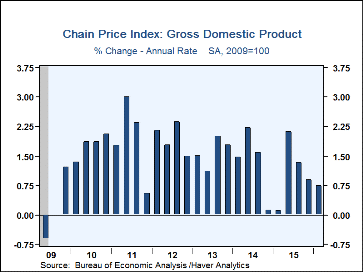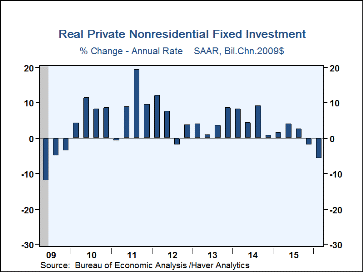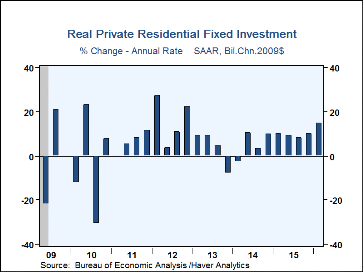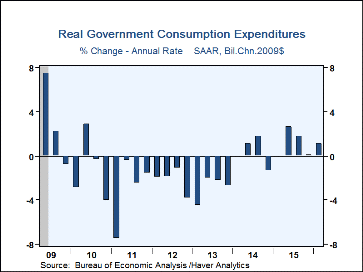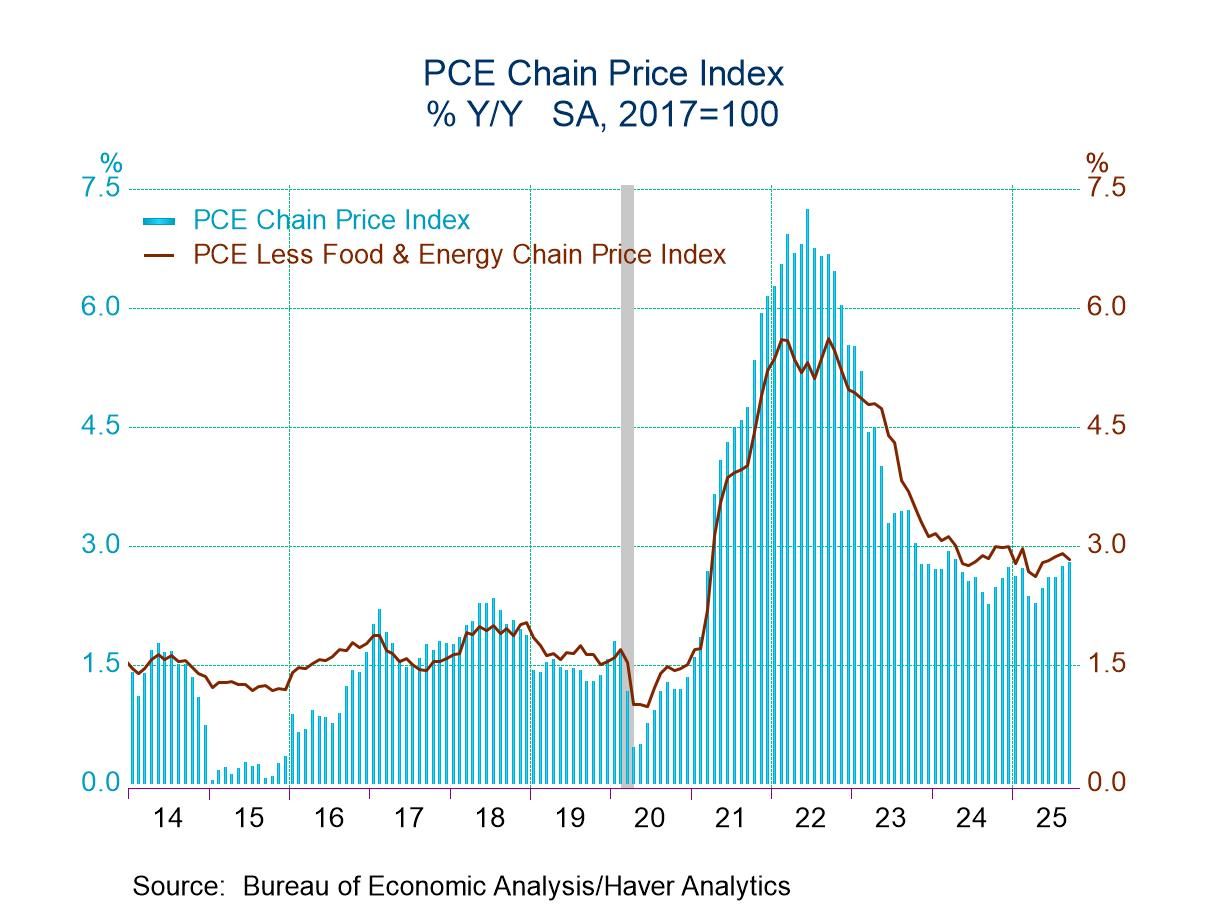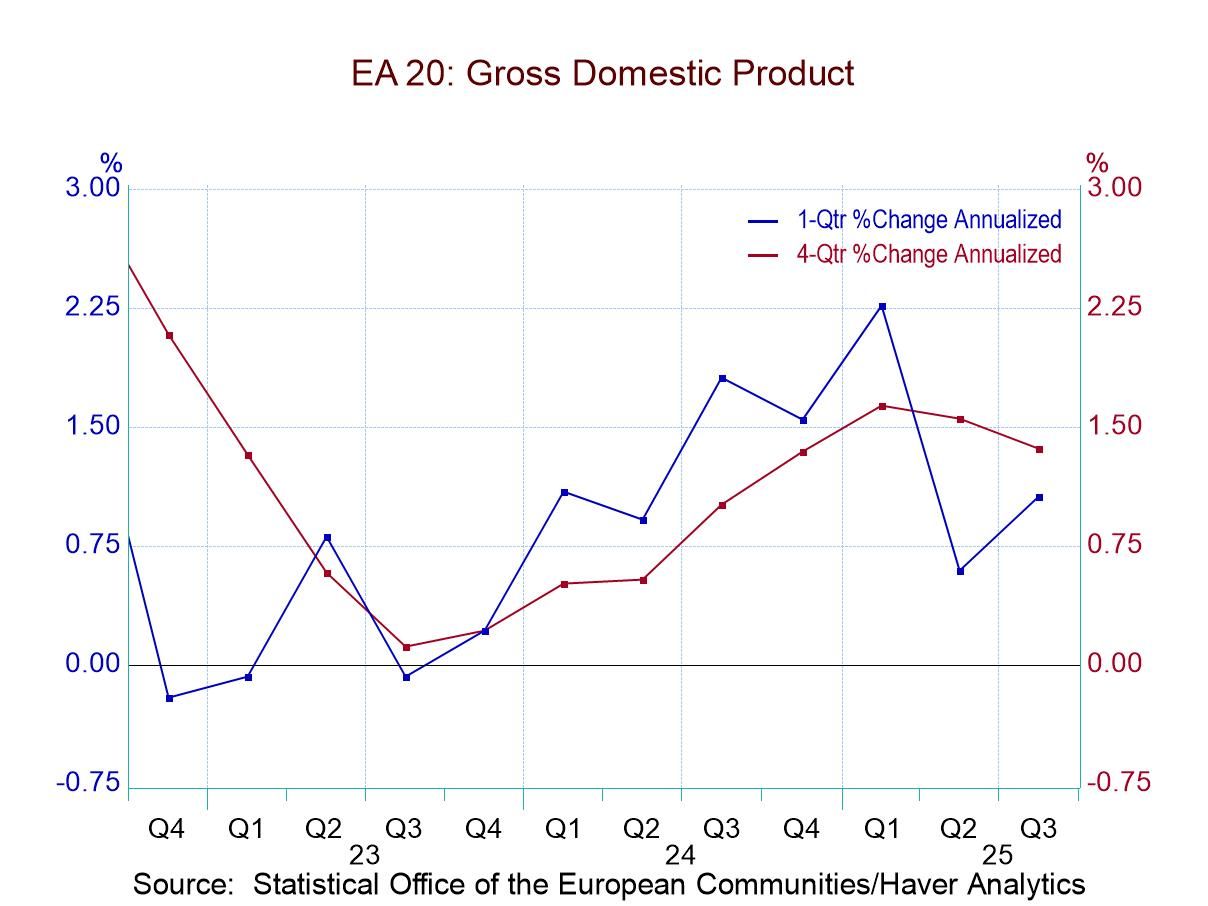 Global| Apr 28 2016
Global| Apr 28 2016U.S. GDP Grows 0.5% in Q1'16
by:Tom Moeller
|in:Economy in Brief
Summary
Growth in the U.S. economy was barely positive last quarter. Real GDP improved 0.5% (SAAR, 1.9% y/y), the weakest rise since a decline in Q1'14. The advance was held back by weaker consumer spending growth, a decline in business [...]
Growth in the U.S. economy was barely positive last quarter. Real GDP improved 0.5% (SAAR, 1.9% y/y), the weakest rise since a decline in Q1'14. The advance was held back by weaker consumer spending growth, a decline in business investment as well as heightened subtractions from foreign trade & inventories. The increase compared to expectations for a 0.7% rise in the Action Economics Forecast Survey. The GDP price index increased at a 0.7% rate (1.3% y/y), its slowest rise in a year.
Consumer spending growth of 1.9% last quarter was its weakest since Q1'15. Growth was held back by a 12.4% decline (-1.7% y/y) in motor vehicle & parts purchases as well as a 2.2% drop (+1.4% y/y) in apparel buying. To the upside was spending on recreational goods & vehicles, which rose 8.5% (10.1% y/y). Spending on home furnishings & appliances increased 4.4% (5.8% y/y) and gasoline buying rose 3.7% (1.4% y/y). In the services area, spending growth remained steady at 2.7% (2.6% y/y). It reflected a fairly constant 6.2% advance (6.0% y/y) in transportation, but a diminished 1.1% gain (3.6% y/y) in restaurant & accommodations. Spending on housing & utilities grew 2.2% (0.2% y/y).
Business spending declined at a 5.9% rate, its second consecutive fall, held back by declining corporate profitability. Investment in structures fell 10.6% (-4.4% y/y). Equipment investment fell 8.6% (-0.3% y/y) while intellectual property product buying gained 1.7% (+2.2% y/y). Continuing to be strong was residential investment which grew 14.9% (10.6% y/y).
Spending by governments grew at a 1.2% rate. Federal spending declined 1.6% (+0.2% y/y), held back by a 3.6% decline (-0.5% y/y) in defense buying. State & local government purchases grew at an accelerated 2.9% rate (2.2% y/y).
Deterioration in the foreign trade accounts subtracted 0.3% percentage points from overall economic growth, the largest subtraction in a year. Exports declined 2.6% (+0.3% y/y), its second consecutive fall. Imports inched 0.2% higher (1.2% y/y), powered by a 3.7% rise (3.5% y/y) in services, with more U.S. citizens traveling abroad. Inventory decumulation subtracted 0.4 percentage points from GDP growth, the third consecutive subtraction.
Pricing behavior was constrained by economic weakness. The GDP price index growth of 0.7% reflected a stable 0.3% rise in the personal spending price index. Nondurable goods prices fell 5.6% (-1.2% y/y) with the decline in gasoline prices. Durable goods prices fell 1.1% (-1.3% y/y), but services prices rose an improved 2.4% (2.1% y/y). The nonresidential investment price index increased 0.2% both q/q and y/y. Residential investment prices gained 1.9% (1.4% y/y) while government sector prices were little changed (0.6% y/y).
The GDP figures can be found in Haver's USECON and USNA database. USNA contains virtually all of the Bureau of Economic Analysis' detail in the national accounts, including the integrated economic accounts and the recently added GDP data for U.S. Territories. The Action Economics consensus estimates can be found in AS1REPNA.
| Chained 2009 $ (%, AR) | Q1'16 (Advance Estimate) | Q4'15 | Q3'15 | Q1'16 Y/Y | 2015 | 2014 | 2013 |
|---|---|---|---|---|---|---|---|
| Gross Domestic Product | 0.5 | 1.4 | 2.0 | 1.9 | 2.4 | 2.4 | 1.5 |
| Inventory Effect | -0.4 | -0.2 | -0.7 | -0.4 | 0.2 | 0.0 | 0.1 |
| Final Sales | 0.9 | 1.6 | 2.7 | 2.3 | 2.3 | 2.4 | 1.4 |
| Foreign Trade Effect | -0.3 | -0.1 | -0.3 | -0.1 | -0.6 | -0.1 | 0.2 |
| Domestic Final Sales | 1.2 | 1.7 | 2.9 | 2.4 | 2.8 | 2.8 | 1.2 |
| Demand Components | |||||||
| Personal Consumption Expenditures | 1.9 | 2.4 | 3.0 | 2.7 | 3.1 | 2.7 | 1.7 |
| Business Fixed Investment | -5.9 | -2.1 | 2.6 | -0.4 | 2.9 | 6.2 | 3.0 |
| Residential Investment | 14.9 | 10.1 | 8.2 | 10.6 | 8.9 | 1.8 | 9.5 |
| Government Spending | 1.2 | 0.1 | 1.8 | 1.4 | 0.7 | -0.6 | -2.9 |
| Chain-Type Price Index | |||||||
| GDP | 0.7 | 0.9 | 1.3 | 1.3 | 1.0 | 1.6 | 1.6 |
| Personal Consumption Expenditures | 0.3 | 0.3 | 1.3 | 1.0 | 0.3 | 1.4 | 1.4 |
| Less Food/Energy | 2.1 | 1.3 | 1.4 | 1.7 | 1.3 | 1.5 | 1.5 |
Tom Moeller
AuthorMore in Author Profile »Prior to joining Haver Analytics in 2000, Mr. Moeller worked as the Economist at Chancellor Capital Management from 1985 to 1999. There, he developed comprehensive economic forecasts and interpreted economic data for equity and fixed income portfolio managers. Also at Chancellor, Mr. Moeller worked as an equity analyst and was responsible for researching and rating companies in the economically sensitive automobile and housing industries for investment in Chancellor’s equity portfolio. Prior to joining Chancellor, Mr. Moeller was an Economist at Citibank from 1979 to 1984. He also analyzed pricing behavior in the metals industry for the Council on Wage and Price Stability in Washington, D.C. In 1999, Mr. Moeller received the award for most accurate forecast from the Forecasters' Club of New York. From 1990 to 1992 he was President of the New York Association for Business Economists. Mr. Moeller earned an M.B.A. in Finance from Fordham University, where he graduated in 1987. He holds a Bachelor of Arts in Economics from George Washington University.



